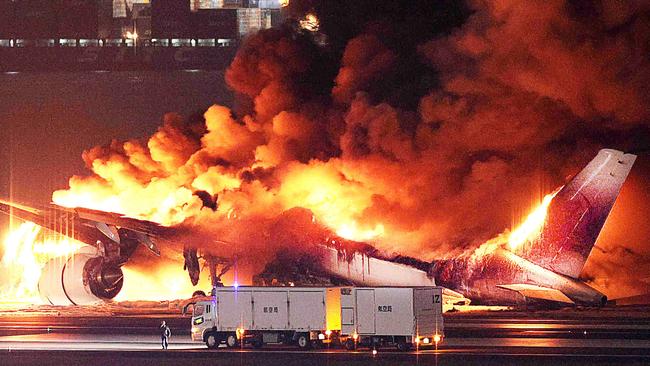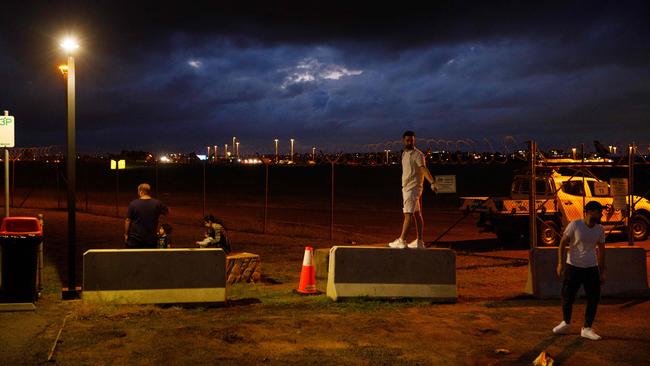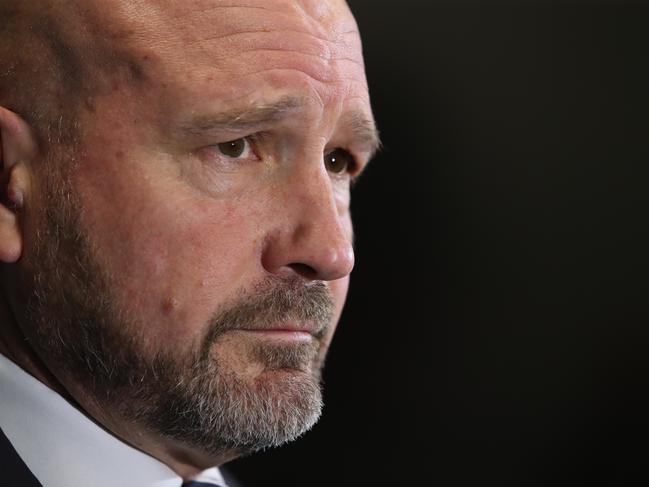Major incidents speak volumes about safety of modern jet airliners
Two major airline incidents in the first week of the year would seem to suggest a very poor start to 2024 for the global aviation industry. How safe are we when we fly?

Two major airline incidents in the first week of the year would seem to suggest a very poor start to 2024 for the global aviation industry.
On January 2, a Japan Airlines Airbus A350 carrying 379 people burst into flames at Tokyo’s Haneda airport after a collision with a Japan Coast Guard aircraft.
Three days later it was Alaska Airlines in the headlines when a door plug came off a Boeing 737 Max 9 with 177 people on board, leaving a refrigerator-sized hole in the aircraft at 16,000 feet. The plane was over Portland, Oregon, and had just taken off on a flight to Ontario, California.

In both incidents, all on board the jetliners survived. Five people on the coast guard aircraft, a Dash-8 turboprop, were not so fortunate, losing their lives in the Haneda airport collision.
Not an ideal outcome by any measure but the result easily could have been so much worse. The fact it wasn’t speaks volumes about the safety of high-capacity commercial airlines and modern jet aircraft. For decades we’ve been told getting on an aeroplane is far less risky than driving a car and the statistics support that. Last year, close to 35 million commercial passenger flights operated worldwide and only two fatal crashes were recorded, neither of them involving jet aircraft.
The previous year, the International Air Transport Association calculated the risk of dying in a commercial airline crash was a mere 0.11 per cent or one in 9.2 million flights. That means on average a person would have to take a commercial flight every day for 25,214 years to experience a crash in which everyone dies.

What’s more impressive is that in every decade since the 1950s, the risk has decreased. In 1959, there were 40 fatal crashes per million aircraft departures. By 1969, that had reduced to two fatal crashes per million and 40 years later the rate was 0.1 in a million. In contrast the risk of a fatal car crash is considerably higher, at 0.49 per cent for every 100 million kilometres.
Respected US aviation safety expert John Cox says the improvement is nothing short of remarkable. “If we had the same accident rate we had in 1970 when I learned to fly, and we thought we were doing pretty well then – if we held that same rate today there would’ve been over 60,000 additional fatalities,” Cox says. “It didn’t happen because we got better. Coming off of 2023, aviation statistically has never been safer.”
Cox says technology, procedures and organisation have all played their part, but probably the “single greatest safety enhancement” was the advent of the jet engine in 1958. “It is much more reliable than the old piston engines of World War II and the 1950s, and that noticeably dropped the accident rate,” says Cox, chief executive of Safety Operating Systems.
“The inclusion of weather radar, being able to get radar on to the aeroplane so you can see and avoid thunderstorms – that’s also made an enormous contribution.”
He cites traffic collision and avoidance systems and ground proximity warning alerts as other key innovations, along with the continuous improvement in modern aircraft design. Aircraft seats, originally made to withstand a static force six times the force of gravity (6G), now are required to withstand a dynamic force of 16G.
Floor proximity lighting introduced in 1986 helps guide passengers to exits in emergencies, while features such as inflatable slides, life vests and seat belts have proven their worth many times over.
A focus on organisational issues and safety management systems adds even greater resilience. Airlines routinely carry out risk assessment, risk tolerability and enforce procedural compliance, with strict timetables for training and retraining of crew.
If that’s not enough, regulators such as the Civil Aviation Safety Authority oversee and enforce certification of aircraft through planned and unplanned inspections.
Last year, more than 14,000 random ramp checks were conducted worldwide by regulators, which have the power to ground aircraft if standards are not met.
Then there are the painstakingly thorough investigations carried out in an effort to raise the safety bar even higher.
“Every incident, no matter how rare, contributes to the industry’s collective knowledge, leading to new safety measures, regulations and technologies,” a CASA spokeswoman says. “This commitment to learning from past events is a key factor in maintaining and increasing the safety of high-capacity commercial jet travel.”
It’s an area Australian Transport Safety Bureau chief commissioner Angus Mitchell knows well.
As the agency responsible for investigating aviation incidents, the ATSB prioritises passenger aircraft events when assessing whether investigations are warranted – even though there has not been a fatal accident involving a large passenger jet in Australia in more than a half-century.
“Some safety occurrences, if not properly examined and addressed, may be precursors to future more serious incidents,” Mitchell says.

“In line with this, the primary objective of our investigations is to ensure any identified safety issues are addressed before they could progress into something more serious.”
It’s no secret that when large plane crashes occur, the ramifications are felt throughout the world.
Every traveller is familiar with how the 9/11 terror attacks in the US changed the way they fly – from extensive airport security checks to impenetrable cockpit doors. But there are many other examples of lessons learned in aviation before and after the events of 2001.
A 1960 crash of a Fokker 27 operated by Trans-Australia triggered the requirement for all commercial aircraft to be fitted with so-called black boxes. With little information to explain the crash that killed 29 people, CASA looked to an invention by Australian David Warren and within a few years all large commercial aircraft worldwide were required to be fitted with a cockpit voice recorder and flight data recorder.
In 1965, a United Airlines crash and subsequent fire on landing at Salt Lake City prompted changes to cabin materials to make them fire resistant. A series of mid-air collisions in the 1970s led to the development of traffic collision and avoidance systems, now a fixture in all modern aircraft.
Even the way in which pilots interact has undergone changes, as a result of a United Airlines crash in Portland in 1978. Ten of the 189 people on board the DC-8 died, when the aircraft ran out of fuel as the crew attempted to troubleshoot a landing gear problem.
“That led to the realisation we had to improve how teams function on the flight deck, and saw the development of team-building skills so crews performed better as a team, particularly in times of crisis,” Cox says.
The still unexplained disappearance of Malaysia Airlines flight MH370 in 2014 led to new regulations requiring airlines to provide 15-minute location updates when flying over water. Many carriers also adopted a “two in the cockpit” at all times rule to ensure one pilot was never left alone on the flight deck.
“It’s a good thing we’re always looking at the way we do business,” says Australian and International Pilots Association president Tony Lucas, a Qantas A330 captain. “Continuous improvement is part of our mantra.”
Lucas says what the industry has now that it did not in the early years is layers of redundancy – from the systems on the aircraft to the support and procedures on the ground. There are few scenarios for which pilots and cabin crew are not prepared, with the recent drama in Tokyo a good example of that. With an engine on fire and smoke starting to fill the cabin of the Japan Airlines A350, flight attendants calmly evacuated all 367 passengers via three emergency slides in a mere 18 minutes.
“I think the investigation will confirm how important it is for a well-trained crew to work as a team together in order to achieve a safe outcome in a dynamic situation,” Lucas says.
Although terrorism and war loom large as the greatest threats to commercial aviation, one of the most serious as far as pilots are concerned is the ongoing balancing act for airlines between commercial considerations and safety.
The pursuit of greater cost efficiencies already has led to the development of technology to allow for single-pilot operations, at the encouragement of airlines such as Cathay Pacific.
Lucas and Cox are of the opinion that moving from two pilots to one, even in the cruise phase of long-haul flights, would be disastrous for aviation safety.
“We’re all for automation that helps us make decisions more effectively and provides us with more clear-cut information, but to think that an autopilot or glorified cruise control is capable of making decisions in a dynamic emergency situation is just folly,” Lucas says.
“It can only do what it’s programmed to do and that’s very much limited by whether or not the emergency you’re having is actually in accordance with what’s been programmed into the computer and how the computer responds.”
Cox agrees, saying taking one pilot out of the cockpit would erode that all important redundancy. “I don’t think we are at or even approaching a point where we can predict every possibility and program a computer to deal with it,” he says.
“As wonderful as technology is, it’s not perfect and the intervention of humans to correct situations that were unanticipated by automation is not at all uncommon.”
Climate change looms as another potential threat, with global warming predicted to increase the intensity of jet streams, leading to more episodes of clear-air turbulence. Cox says research is under way to develop a means of detecting otherwise invisible clear-air turbulence in real time, which would be a significant advance.
“That technology is probably the next major step forward as far as injury goes,” he says. “Clear-air turbulence doesn’t cause accidents but it does cause injury and death (in the cabin) because people are not always strapped down. It’s very serious.”
The more immediate focus for the industry is the events that led to the Alaska Airlines door plug blowout and the Haneda airport collision, and what that will mean for pilots, crew, air traffic controllers, engineers and aircraft manufacturers.
IATA senior vice-president for operations, safety and security Nick Careen says we should have faith in a system that has worked to the benefit of the travelling public for many years now.
“We acknowledge the concerns people may have following recent incidents,” Careen says.
“However, it’s important to put these in the context of the overall safety record of the industry. Accidents are rare, and will continue to get rarer.”




To join the conversation, please log in. Don't have an account? Register
Join the conversation, you are commenting as Logout